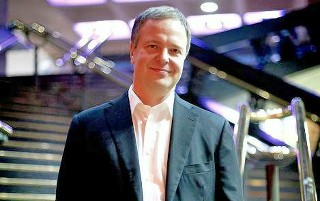|
Back
With Cutlass And Vision New York
Avery Fisher Hall, Lincoln Center
02/26/2015 - & February 27, 28, 2015
Jean Sibelius: Aallottaret, Opus 73 – Violin Concerto in D minor, Opus 47
Johannes Brahms: Symphony No. 2 in D major, Opus 73
Frank Peter Zimmermann (Violin)
New York Philharmonic Orchestra, Sakari Oramo (Conductor)

S. Oramo (© Benjamin Ealovega)
Sakari Oramo is perhaps the most formidable-looking conductor to stand before the New York Philharmonic in years. A one-time concertmaster, he comes with a baton that seems longer than a violin bow. He thrusts that baton forward on his dais like Saladin on the walls of Cairo, sways with the orchestra, bows, summons up his sounds, and builds a mighty musical arch which simply has to be impressive.
And it is. Mr. Oramo is one of the crusading herd of Finnish musicians who monopolize the musical scene here and in Europe. And he is hardly the least of the breed. Chief Conductor of the Royal Stockholm Orchestra and the BBC Symphony Orchestra, he is principal conductor of opera and chamber orchestras, as well as honorary conductor of his own country’s Radio Symphony Orchestra.
If last night’s debut with the New York Philharmonic is any indication (he has been too busy in Europe to try conquering North America), Mr. Oramo could become a star here as well. He handled the NY Phil with aplomb, with tremendous presence, and–not incidentally by any means–with results as well.
While the first half of the program was the most surprising, the most satisfying moments came with the Brahms Second Symphony. The opening was not faster than usual, but Mr. Oramo offered a fullness and a fluidity which made the symphony move inexorably forward. This was drama, mighty, the dolce moments not as important as the energy leading to the great climax.
The second movement also had this undercurrent of tension, and I almost didn’t recognize the Allegretto. It didn’t sound like Brahms at all, but whipped along like something from Tchaikovsky’s Nutcracker. Thus, the sudden change of tempo came as a jolt, rather than a Brahms simple contrast.
As one could imagine, the “spirit” of the Allegro con spirito was foremost. Mr. Oramo allowed the orchestra all the movement it needed to make that final soaring windeup. The arching scales, the thumping timpani and horn/trumpet repeated notes surged under his powerful baton, and even the Brahms pauses were like race horses pawing at the starting gate, ready to run. It was, frankly, Brahms which belied the old-fashioned view that the composer was following the rules, making a powerful piece of engineering. This was an emotional powerhouse.

F. P. Zimmermann (© Courtesy of the artist)
Still, the great surprise of the evening was Frank Peter Zimmermann’s performance of the Sibelius Violin Concerto.
Barely a week ago, Anne-Sophie Mutter produced her own version, a lyrical testament to Sibelius the melodist. Nothing could have been further from that with Mr. Zimmermann’s Sibelius. From the beginning, this was tough, rough, angry, sheerly aggressive. Where Ms. Mutter played the first movement with a balance of fervor and glistening strings, Mr. Zimmermann took the opening theme almost without vibrato, mysterious, almost scary. After that, he attacked (and that is the word) playing hard on the strings, pushing the movement hard. Yes, the Sibelius is noted as an archetypal late 19th Century concerto, but Mr. Zimmermann pushed it deeply into the 20th Century. Not in musical techniques, of course, but in surface anger.
The second movement was equally dark but played with Mr. Zimmermann’s usual transparent technique, wondrous phrasing. The finale was sharp, mordant, the evil elves hiding in Sibelius’ rustic forestry.
The soloist had a few advantages here. First, as the New York Philharmonic artist-in-residence last year, he understood the orchestra, as they understood him. Second, this was a unique configuration. Sibelius was a good violinist, conductor Oramo started as a violin virtuoso, and Mr. Zimmermann is...well, of course, he is Frank Peter Zimmermann, a man never shy of opinions political and musical, and bless him for both as well as the sparkling Bach encore.
The opening was a rarity indeed. Jean Sibelius came to America in 1914, having been commissioned here to write his tone-poem, The Oceanides. The piece is typically atmospheric, and Mr. Oramo led it with all the requisite tension.
Which brings up the exhibit in Avery Fisher hall for the 150th Anniversary of Sibelius’ birth. While part of it is a showing of his letters and communications, even more important are stills from a movie made about his country life. It is quite wonderful, prudently omits reference to his drinking, and is a picturesque, if hardly complete picture of the esteemed composer at his most bucolic.
Harry Rolnick
|